Here is an English translation of my blog on Ellora Caves
In 2012, we planned only to go on a pilgrimage to Nashik and Shirdi, but as always happened to me, when the itinerary of travel was being worked out, I was taken over by my desire to roam around and see nearby places. My younger brother-in-law Mr Kamlesh Prasad was our guide for Shirdi pilgrimage and he was to return via Pune. Aurangabad fitted well into his pre-planned itinerary, so we decided to visit Ajanta ( see my earlier blog) & Ellora caves. From Shirdi we went to Aurangabad by bus and for two days the SUV was booked. The first stop was the Ellora Caves after the consecration of Ghrishneshwar Jyotirlinga.
In 2012, we planned only to go on a pilgrimage to Nashik and Shirdi, but as always happened to me, when the itinerary of travel was being worked out, I was taken over by my desire to roam around and see nearby places. My younger brother-in-law Mr Kamlesh Prasad was our guide for Shirdi pilgrimage and he was to return via Pune. Aurangabad fitted well into his pre-planned itinerary, so we decided to visit Ajanta ( see my earlier blog) & Ellora caves. From Shirdi we went to Aurangabad by bus and for two days the SUV was booked. The first stop was the Ellora Caves after the consecration of Ghrishneshwar Jyotirlinga.
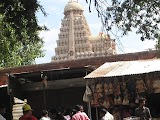 | 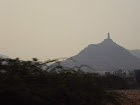 |  |
| Ghrishneshwar Jyotirlinga. | Views on way | Biwi ka makbara |
While Ajanta is famous for its paintings, Ellora is famous for its own unique rock sculptures - calling it "the greatest experiment on rocks" would not be an exaggeration. The caves here are like an art gallery : the walls, floors, roofs are all adorned with rock sculptures. Ellora also has many paintings but they are not in good condition. Ellora is a UNESCO World Heritage site and the largest monastery cave group in the world. It is located at a distance of 30 km from Aurangabad. We first went north to the cave group no 21-34. Cave 29-21 was close to the parking lot. All the caves are built by cutting the steep rocky stones. The cave no 30–34 are Jain caves. Cave nos 13-29 are Hindu caves and the remaining 1-12 are Buddhist caves (towards south side). The caves were built in 600-1000 BC. The most famous cave is Cave No 16 which is also known as Kailash Temple. Between 757-783 AD, Rashtrakuta king Krishna-I built this cave temple by carving the stone from top to bottom. That is, the pinnacle of the temple was built first and then the rest of the temple was carved fron top to down. Ellora cave groups also has a small Kailash and an Indra Sabha. Apart from these, there are also 25-30 small caves like Ganesh Leni and Jogeshwari caves which we could not visit.
At first we stopped in the parking lot near the 29th cave and after seeing all the caves nearby, went towards the 32nd cave and saw the Jain caves. Finally we went towards cave no 16 (Kailash) and saw cave no 16 to 1. Some caves were being repaired and we had to be contented by looking at them from outside. There was also a tea & snacks shop near the parking lot and we purchased some light snacks, water and tea . First let's talk about Jain caves. Five Jain caves at Ellora date back to the 9th and 10th centuries. They all belong to the Digambara sect. Jain caves reveal distinct dimensions of Jain philosophy and tradition. These caves depict a strict meaning of 'tapa' - they are not relatively large compared to others, but they present exceptionally elaborate art works.The most important Jain temples are Chhota Kailash (cave 30), Indra Sabha (cave 32) and Jagannath Sabha (cave 33). Cave 31 is an unfinished four-pillared hall / temple. Cave 34 is a small cave, which can be entered from the left side of Cave 33.
At first we stopped in the parking lot near the 29th cave and after seeing all the caves nearby, went towards the 32nd cave and saw the Jain caves. Finally we went towards cave no 16 (Kailash) and saw cave no 16 to 1. Some caves were being repaired and we had to be contented by looking at them from outside. There was also a tea & snacks shop near the parking lot and we purchased some light snacks, water and tea . First let's talk about Jain caves. Five Jain caves at Ellora date back to the 9th and 10th centuries. They all belong to the Digambara sect. Jain caves reveal distinct dimensions of Jain philosophy and tradition. These caves depict a strict meaning of 'tapa' - they are not relatively large compared to others, but they present exceptionally elaborate art works.The most important Jain temples are Chhota Kailash (cave 30), Indra Sabha (cave 32) and Jagannath Sabha (cave 33). Cave 31 is an unfinished four-pillared hall / temple. Cave 34 is a small cave, which can be entered from the left side of Cave 33.
 | 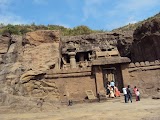 | 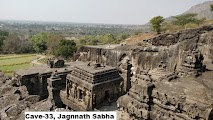 |
| Cave 32-34 | Cave 32 | Cave 33 |
 |  |  |
| Cave 33 | Cave 34 | Cave 32 |
 |  | 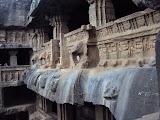 |
| Cave 30- | Cave 34-Ambika | Cave 32 |
Hindu caves are 13 to 29. These caves were built between the seventh to the ninth centuries. In terms of creativity and construction skills, these caves are incomparable. Cave Nos 14, 15, 16, 21 and 29 are more famous among these caves.Cave No 13 is a simple cave, which was probably a grain store, while Cave No 14 was a Buddhist vihara which was converted into a temple dedicated to Shiva sometimes in the 7th century. Cave 15 is also known as Dasavatar (the ten incarnations of Vishnu) cave. Cave 16, is one of the finest temples of Ellora. In the three-storey temple, one Shiva emerges from Nataraja and one from Shiva Lingam, while Vishnu and Brahma pay homage. Caves 17 to 20 and Caves No. 22 to 28 are simple temple caves. Cave No 21, popularly known as Rameshwar Cave, has interesting interpretations of familiar Shaiva scenes depicted in earlier temples. The figure of Goddess Ganga standing on Makara (mythical sea creature) is particularly notable. Big Cave No. 29 i.e. Dumar Leena, is considered one of the simple caves and Kailash is one of the fully developed temples.
 | 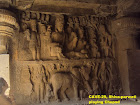 |  |
| Cave 29. Ravana | Cave 29.Shiva playing | Cave 29. |
| rocking Kailash | Choupad | Kalyansundermurti |
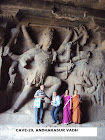 | 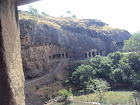 | 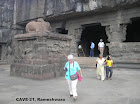 |
| Killing of Andhakasur | Path way Cave29-21 | Cave 21 - Rameshwaram |
 | 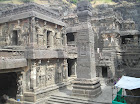 | 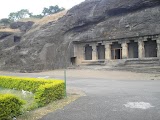 |
| Entry to Cave 16 | Cave 16-Kailash | Cave-14 |
Caves 1 to 12 are Buddhist caves. Cave 6 is considered to be the oldest cave, followed by Cave 5, Caves 2, 3, 4 and then Caves 11 and 12. Caves 11 and 12 are three storeys and the latest excavation at the Buddhist complex at Ellora. Ellora was an important center of Tantric (Vajrayana) Buddhism. We do not find any concrete evidence of the existence of Hinayana in Ellora. Yes, Mahayana caves are here.
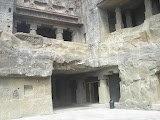 | 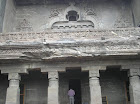 |  |
| Cave 9 | Cave 10 | Cave 10 Chaitya |
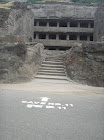 |
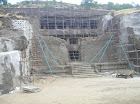 |
 |
| Cave 11 | Cave 12 | Cave 2 |
 |  | 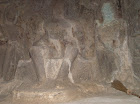 |
| Cave 1-9 | Cave 2 | Cave 2 |
Some random photos are given below
 |  |  |
| गुफा 16 | गुफा 16 | गुफा 21 |
 |
 |
 |
| गुफा 32 | गुफा 10 | हमारे 8 में से 6 सदस्य |
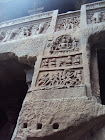 |
 |
 |
| अमृत मंथन | गुफा 33 | गुफा 21 |
Keep watching this blog for more of my travel exploits.
No comments:
Post a Comment